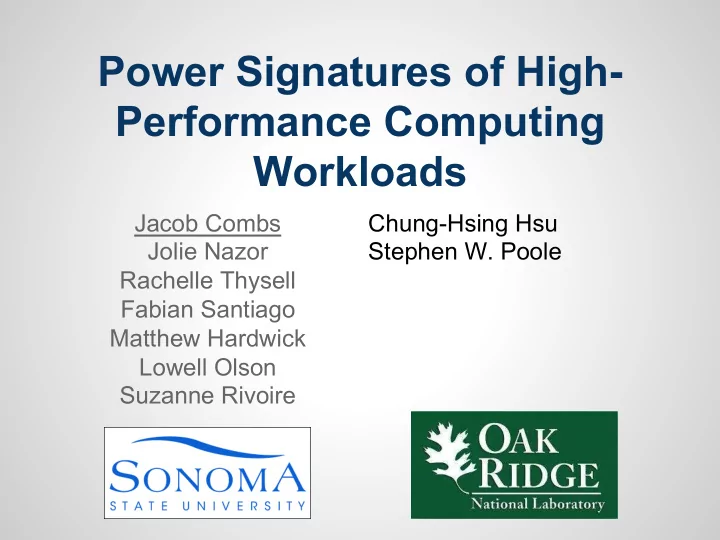

Power Signatures of High- Performance Computing Workloads Jacob Combs Chung-Hsing Hsu Jolie Nazor Stephen W. Poole Rachelle Thysell Fabian Santiago Matthew Hardwick Lowell Olson Suzanne Rivoire
Motivation ● Job scheduling as a Tetris game ● Driven by power usage patterns. Can we: o Associate a pattern with each application? o Enhance scheduler with pattern information?
Motivation ● Qualitative patterns in applications’ traces FFT CUBLAS
Talk Outline ● Research questions ● What is a power signature? ● Methodology: o Signature validation o Experimental setup ● Results ● Current and future work
Research Questions ● Can we summarize HPC workloads’ power behavior into distinctive signatures? ● Is such a signature consistent across o runs? o input data? o hardware configurations? o hardware platforms? ● How well (quantitatively) does a signature distinguish a workload?
What is a power signature? A. The trace itself: vector of power measurements. B. Statistical summary of the trace
Time-series-based Signature How do we quantify the difference between two traces? 1. Mean Squared Difference (MSD) o Match power observations pairwise, and take MSD o Traces must be same length 2. Dynamic Time Warping (DTW) o Identifies similarities of two time series o Accounts for offsets and differences in periodic frequency
Feature-based Signature What features are useful? ● Basic statistics: o 2-vector: < Maximum, Median > o (Divide each by trace’s minimum power) o Call this MaxMed ● More involved statistics that have been found useful in time-series clustering: o Standard Deviation + 11 other features o Augmented with MaxMed , call this stat14 .
Signature Validation ● Clustering: “optimally” partition a set of traces ● Classification: automatically identify the label (e.g. workload) of a trace
Signature Validation: Clustering ● Input: o Data points (traces) o Notion of distance (signature) ● Output: Partition Algorithms: ● kmeans: centroid-based clustering ● dbscan: density-based clustering ● hclust: hierarchical clustering o dendrograms
Signature Validation: Clustering Our signature is good if the partition is good. How do we know a partition is good? 1. Look at the partition qualitatively: Are workloads grouped together? 2. Quantitatively compare partition to some “ideal” reference. o Example ideal reference: grouped by workload
Signature Validation: Classification Algorithm: Random forest Leave-one-out accuracy measures a signature’s utility Bonus: Variable importance measures
Experimental Setup 255 power traces from 13 benchmarks. ● (Baseline) ● Synthetic: Power ● SystemBurn*: Model Calibration** ○ FFT1D ● Sort ○ FFT2D ● Prime95 ○ TILT ● Graph500 ○ DGEMM ● Stream ○ GUPS ● Linpack-CBLAS ○ SCUBLAS ○ DGEMM+SCUBLAS ** Rivoire et al, Hot Power, 2008 * Josh Lothian et al., ORNL Technical Report, 2013
Experimental Setup Watts Up? Pro power meter reports power consumption once per second.
Clustering Results ● OCRR data o n=30 o 6 workloads (different input configurations) ● Algorithm: hclust ● Signature: raw trace ● Distance: MSD 2-clustering: ● Top: Stream, Prime95, Linpack-CBLAS (CPU-intensive) ● Bottom: Calib, Baseline, Sort
Clustering Results ● OCRR data o n=30 o 6 workloads (different input configurations) ● Algorithm: hclust ● Signature: stat14 ● Distance: Manhattan 4-clustering: ● Stream, Prime95, Linpack- CBLAS ● Sort ● Baseline ● Calib
Clustering Metric Ideal clustering: by workload. Info-theoretic measure of partition similarity: Adjusted Normalized Mutual Information (Derived from NMI) ● NMI = (Mutual information) / (Joint entropy) ● NMI is between 0 (worst) and 1 (best) ● Expected ANMI of two random partitions is 0.
Clustering Results ● Data: o LCRF (n=225) o LC (n=111) o RF (n=114) ● Algorithm: hclust ● Signature: MaxMed Signatures may be more consistent within hardware platform
Clustering Results ● Data: LC (n=111) ● Algorithm: hclust MaxMed and DTW signature methods are more effective than Stat14 and MSD
Classification Results ● Trained a random forest classifier on LCRF data (n=225) ● Using MaxMed or Stat14 yields leave-one- out accuracy >80%
Classification Results Gini variable importance suggests: ● MaxMed is a good subset of Stat14 ● Try Stat3 : < Normalized Maximum, Normalized Median, Serial Correlation >
Classification Results ● Stat3 classifier labels traces with >85% accuracy
Conclusions ● We evaluated different types of signatures: o Time-series-based o Feature-based ● Some workloads have unique signatures, some workloads are less easily distinguished from others. ● Signatures can distinguish workloads across hardware platforms, but are more effective given data from a single machine type.
Current and Future Work ● Expand to: o Heterogeneous workloads o MPI/distributed workloads o Finer-grained or coarser-grained samples ● Online workload recognition ● Workload-aware energy-efficient scheduling
Acknowledgements This work was supported by the United States Department of Defense (DoD) and used resources of the DoD-HPC Program at Oak Ridge National Laboratory.
Afterthought: Clustering Again ● Data: LC (n=111) ● Algorithm: hclust Stat3 is not obviously better than MaxMed for clustering
Backup: More Clustering Results ● Data: LCRF (n=225) ● Algorithm: hclust The result holds for multiple platforms: MaxMed and DTW signature methods are more effective than Stat14 and MSD
Recommend
More recommend